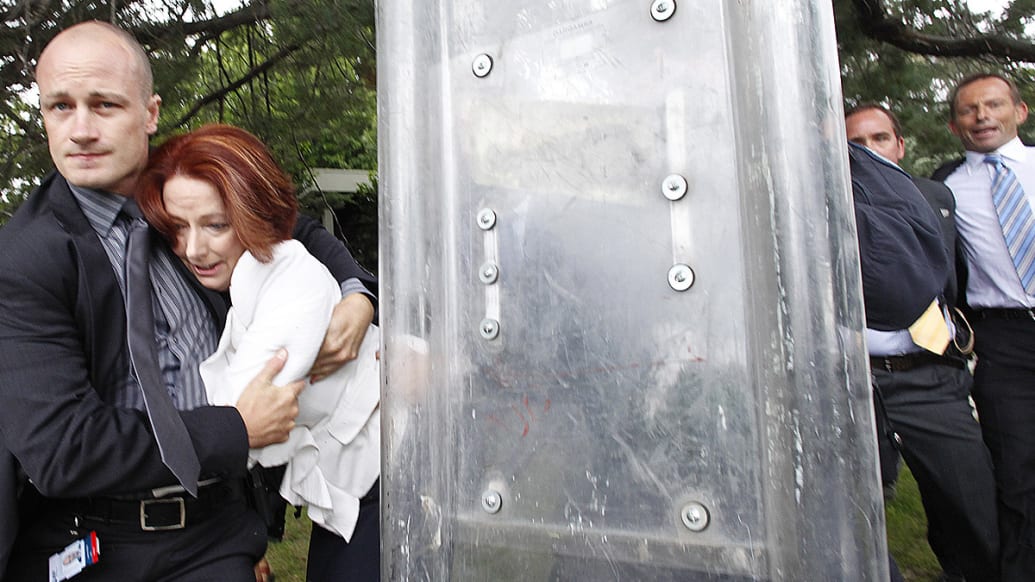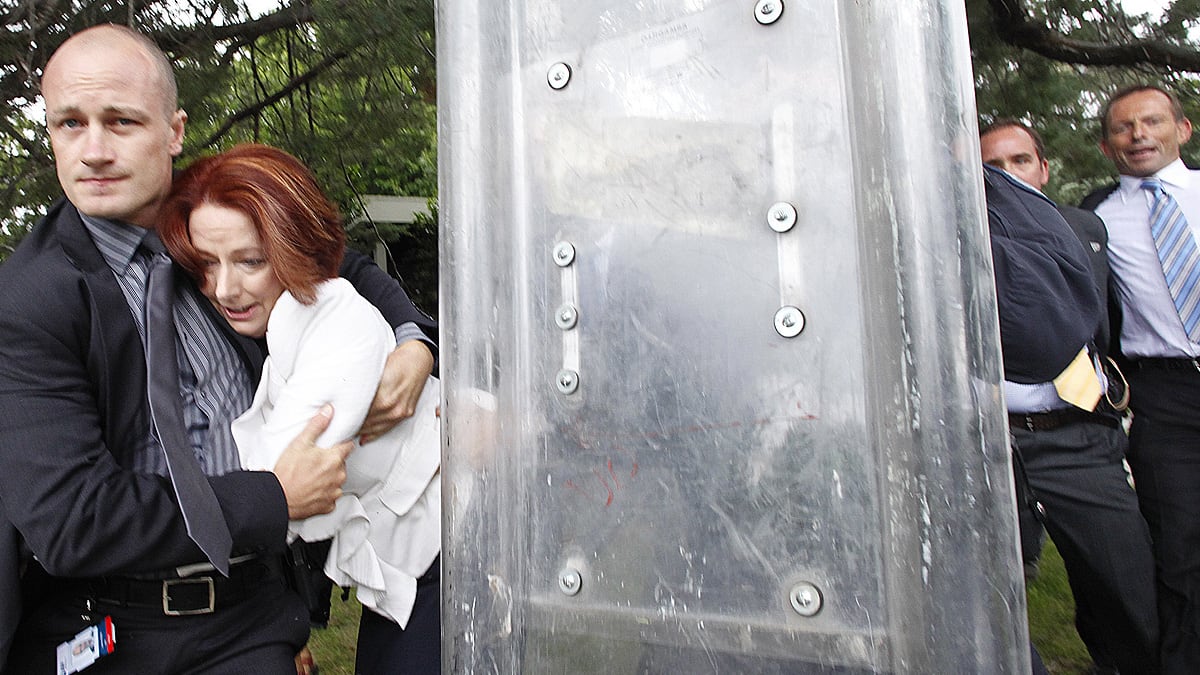Reagan got a bullet in the chest. Murdoch took a pie to the face. Berlusconi’s brief political punishment came in the form of an attack with a novelty statuette of the Milan Cathedral. On the principle that people sympathize with a leader who is physically threatened, Australian Prime Minister Julia Gillard’s lost blue suede pump, abandoned Thursday in a confrontation with Aboriginal land-rights protesters, might just provide a shot in the arm for the leader’s lackluster first term in office.
Forty years ago, four indigenous men set up camp on the lawn of Old Parliament House in protest over Aboriginal rights. The site became known as the Aboriginal Tent Embassy, and has been under semipermanent occupation ever since. On the morning of Australia Day, this past Thursday, Tony Abbott was asked by reporters for his position on the protest. He responded, sotto voce, “I think a lot has changed and I think it’s probably time to move on from that.” Later that day, Julia Gillard and the leader of the opposition, Tony Abbott, found themselves trapped inside a restaurant by angry supporters of the Tent Embassy.
A member of the Tent Embassy was tipped off that Abbott was dining just around the corner, and some 200 protesters descended on the Lobby restaurant, where Gillard and Abbott were both attending a closed-door awards ceremony. Chants of “racist” and “shame” flowed into the restaurant, as some protesters began banging on the glass doors.
Fifty riot police were called to the scene; 20 minutes later, the politicians fled the building under police guard. Gillard, half-stumbling, lost a shoe as she was bundled by her bodyguard into an a waiting car. Images of the leader surrounded by a phalanx of police officers made global news.

But perhaps taking cues from her fellow victims of political protest who made gains from their confrontations, Gillard delivered a show of poise while still in the building, in a scene captured on camera and played throughout the day on Australian network news. The key in such situations is to stay cool: Ronald Reagan proved as much when he insisted on walking into the George Washington University Hospital unaided and quipping his way through emergency surgery. (He greeted his wife with the line, “Honey, I should have ducked.”) His public approval soared to 79 percent.
On the video, a member of Gillard’s personal security detail is seen bluntly advising the prime minister that the situation outside the restaurant “is deteriorating,” and that it is time to move quickly. Gillard appears to calmly assent before turning her thoughts to her political rival, Tony Abbott. “And what about Mr. Abbott? Where have we got him?” she asks, making sure he is included in exit plans, even joining Abbott on the other side of the room to brief her rival.
Gillard’s approval rating has rarely reached the upper 30s since she took office in November 2010. A brutal ousting of her predecessor and a subsequent u-turn on an environmental-policy campaign pledge have helped Gillard’s opponents paint her as duplicitous and untrustworthy. Assailing her at every turn has been her rapacious political rival, Tony Abbott.
Perhaps Gillard’s willingness to secure the safety and well-being of a man long fixated on her political destruction will win her some temporary respite from Canberra’s political chicanery.
Then again, maybe not. On Friday evening, Tony Hodges, a media adviser to Gillard, was forced to resign for having tipped off someone as to where they could find Abbott, who then told a member of the Aboriginal Tent Embassy.
Meanwhile, late Friday reports emerged from Canberra that Abbott’s party will push for a federal police investigation into just who else in the prime minister’s office knew about the leak of Abbott’s daily schedule. Gillard’s team issued a press release that stated Hodges “did not in any way encourage violence or demonstration.” But a frontbencher from the opposition later told Sky News he thought Hodges was a “scapegoat” in a wider conspiracy involving the Gillard office.
“Obviously if this staffer acted alone, it would be very surprising,” said the frontbencher.
Regardless, while Thursday’s images may have helped to humanize the embattled Gillard, a staunch liberal, they have also galvanized conservative pundits and politicians against the protesters.
Australia’s deep rift along race lines was on display by Friday, as protests by land-rights activists in the capital of Canberra continued into a second day. By mid-afternoon, around 400 Tent Embassy protesters marched on Parliament House, burning an Australian flag a short distance from the building. A 15-year-old girl leading the burning chanted for sovereignty: “Always was, always will be Aboriginal land.”
Another protester announced the Australian flag had allowed “white people to rape, murder, and destroy our people for 224 years.” Several international reports of Thursday’s protest focused on the plight of the country’s approximately 500,000 Indigenous Australians. The statistics are staggering. Indigenous Australians are 11 times more likely to go to prison. Most are on welfare. The murder rate is six times higher than the national average and there is a 17-year gap in life expectancy. Sixty percent of indigenous students do not graduate from high school. Suicides are twice the national average. And a 2010 U.N. report into Australia’s race relations found “entrenched racism” throughout the country.
In Australia, fury over Thursday’s confrontation was palpable in some media reports. Conservative pundit Andrew Bolt, in a column filled with references to “we” and “they,” issued a plea to “end the politics of reconciliation.” “We hold welcome-to-the-country ceremonies and pay respects to Aboriginal elders at government and sporting events to show our good hearts,” he writes. “We've introduced what seems to me apartheid justice ... and had judges show extraordinary leniency to Aboriginal offenders on the grounds of their culture.”
Another Australian commentator, David Penberthy, called the Tent Embassy protest “a new low in the four-decade history of this politically useless eyesore.”
But it may be a new high for Australia’s much-maligned prime minister.

